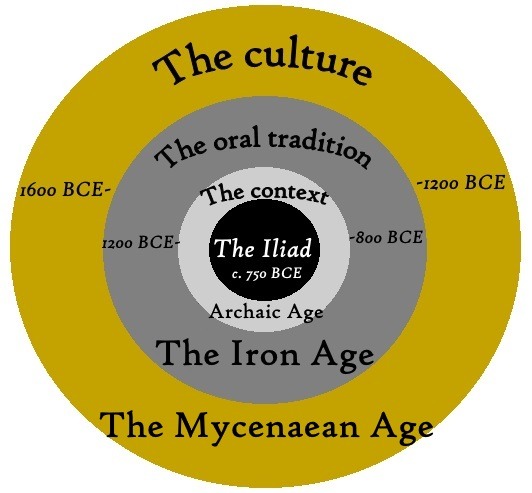The Iron Age
c. 1200 - 800 BCE
The declining use of megarons as palaces and trade centers resulted in decreased production of physical artifacts. Though this age continued to produce normally, it did not produce artifacts of equal grandeur to the previous Mycenaeans. Because living groups centered less around megarons and became more individualistic, literacy dropped. As reading and writing decreased, oral tradition flourished.
Stories and legends continued as people lived in and around abandoned megarons and Bronze Age ruins, wondering what sort of people lived such a glorious existence. Mycenaean and newborn legends developed into fine art during this age, passing down the mythology of their history. Many of these legends and stories were religious and many were larger than life. These legends remained like bedtime stories; everyone knew them, and everyone told them, thus resulting in a myriad of retellings and interpretations. Despite their various forms of contested truth, the stories still contained the historical and societal context of the characters within them.
History's Influence on The Iliad

Chart created by author. This chart depicts the amount of influence the different historical ages had upon the stories in The Iliad. Written in the beginning of the Archaic Age using stories passed down through the Iron Age about events in the Mycenaean Age.
When the megarons collapsed, so did their trade routes. They were no longer able to acquire the bronze that named the previous age. Instead, the use and manufacturing of iron became the prominent metallurgy, so historians referred to it as the Iron Age. These ages are only titles given by historians to depict prominent trends in history. In reality, each age flowed into each other.
HINT:
When reading The Iliad, look out for points where it references the use of iron. The presence of iron is an interesting anachronism within The Iliad. In Book 23, Achilles offers iron as a prize for one of the funeral games for Patroclus:
Rise up, you who would endeavor to win this prize also.
For although the rich demesnes of him who wins it lie far off
Indeed, yet for the succession of five years he will have it
To use; for his shepherd for want of iron will not have to go in
To the city for it, nor his ploughman either. This will supply them.
Il., 23.831-835
The Mycenaean Age did see the use of iron, but it usually came from Cyprus and it was a precious commodity used for elaborate gifts and rituals. Mainland Greece did not see the steady manufacturing of iron until the Iron Age.
![]()
CRITICAL THINKING:
How could stories based in the Mycenaean Age (16th to 12th cen. BCE) contain iron, an invention that comes later in the Iron Age (12th to 8th cen. BCE)?
![]()
